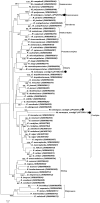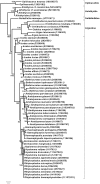Nuttalliella namaqua: a living fossil and closest relative to the ancestral tick lineage: implications for the evolution of blood-feeding in ticks
- PMID: 21858204
- PMCID: PMC3157464
- DOI: 10.1371/journal.pone.0023675
Nuttalliella namaqua: a living fossil and closest relative to the ancestral tick lineage: implications for the evolution of blood-feeding in ticks
Abstract
Ticks are monophyletic and composed of the hard (Ixodidae) and soft (Argasidae) tick families, as well as the Nuttalliellidae, a family with a single species, Nuttalliella namaqua. Significant biological differences in lifestyle strategies for hard and soft ticks suggest that various blood-feeding adaptations occurred after their divergence. The phylogenetic relationships between the tick families have not yet been resolved due to the lack of molecular data for N. namaqua. This tick possesses a pseudo-scutum and apical gnathostoma as observed for ixodids, has a leathery cuticle similar to argasids and has been considered the evolutionary missing link between the two families. Little knowledge exists with regard to its feeding biology or host preferences. Data on its biology and systematic relationship to the other tick families could therefore be crucial in understanding the evolution of blood-feeding behaviour in ticks. Live specimens were collected and blood meal analysis showed the presence of DNA for girdled lizards from the Cordylid family. Feeding of ticks on lizards showed that engorgement occurred rapidly, similar to argasids, but that blood meal concentration occurs via malpighian excretion of water. Phylogenetic analysis of the 18S nuclear and 16S mitochondrial genes indicate that N. namaqua grouped basal to the main tick families. The data supports the monophyly of all tick families and suggests the evolution of argasid-like blood-feeding behaviour in the ancestral tick lineage. Based on the data and considerations from literature we propose an origin for ticks in the Karoo basin of Gondwanaland during the late Permian. The nuttalliellid family almost became extinct during the End Permian event, leaving N. namaqua as the closest living relative to the ancestral tick lineage and the evolutionary missing link between the tick families.
Conflict of interest statement
Figures





References
-
- Barker SC, Murrell A. Systematics and evolution of ticks with a list of valid genus and species names. Parasitology. 2004;129:S15–S36. - PubMed
-
- Guglielmone AA, Robbins RG, Apanaskevich DA, Petney TN, Estrada-Pena A, et al. The Argasidae, Ixodidae and Nuttalliellidae (Acari: Ixodida) of the world: a list of valid species names. Zootaxa. 2010;2528:1–28.
-
- Klompen JSH, Black WC, 4th, Keirans JE, Norris DE. Systematics and biogeography of hard ticks, a total evidence approach. Cladistics. 2000;16:79–102. - PubMed
-
- Klompen H, Lekveishvili M, Black WC., 4th Phylogeny of parasitiform mites (Acari) based on rRNA. Mol Phylogenet Evol. 2007;43:936–951. - PubMed
-
- Klompen H. Holothyrids and ticks: New insights from larval morphology and DNA sequencing, with the description of a new species of diplothyrus (Parasitiformes: Neothyridae). Acarologia. 2010;50:269–285.
Publication types
MeSH terms
Substances
Associated data
- Actions
- Actions
- Actions
- Actions
LinkOut - more resources
Full Text Sources
Molecular Biology Databases

